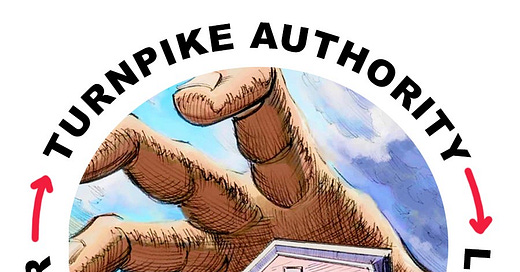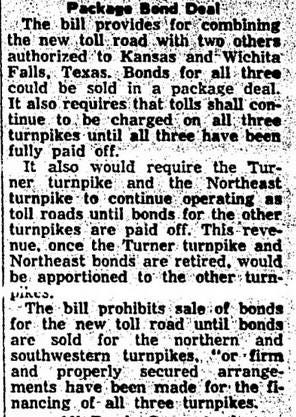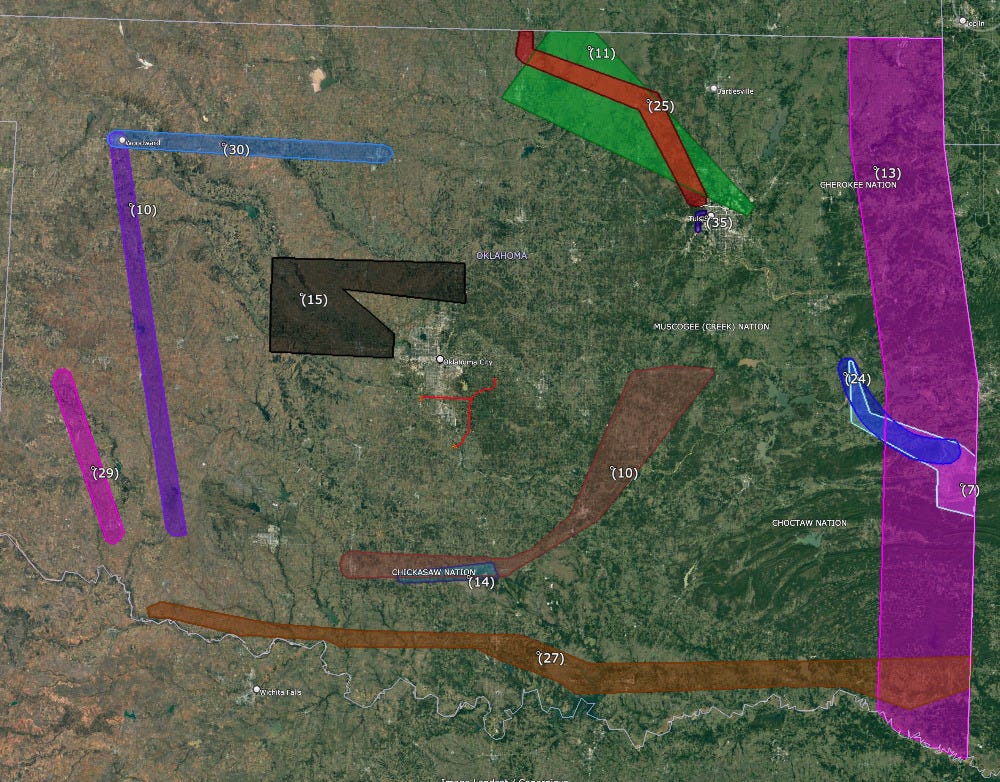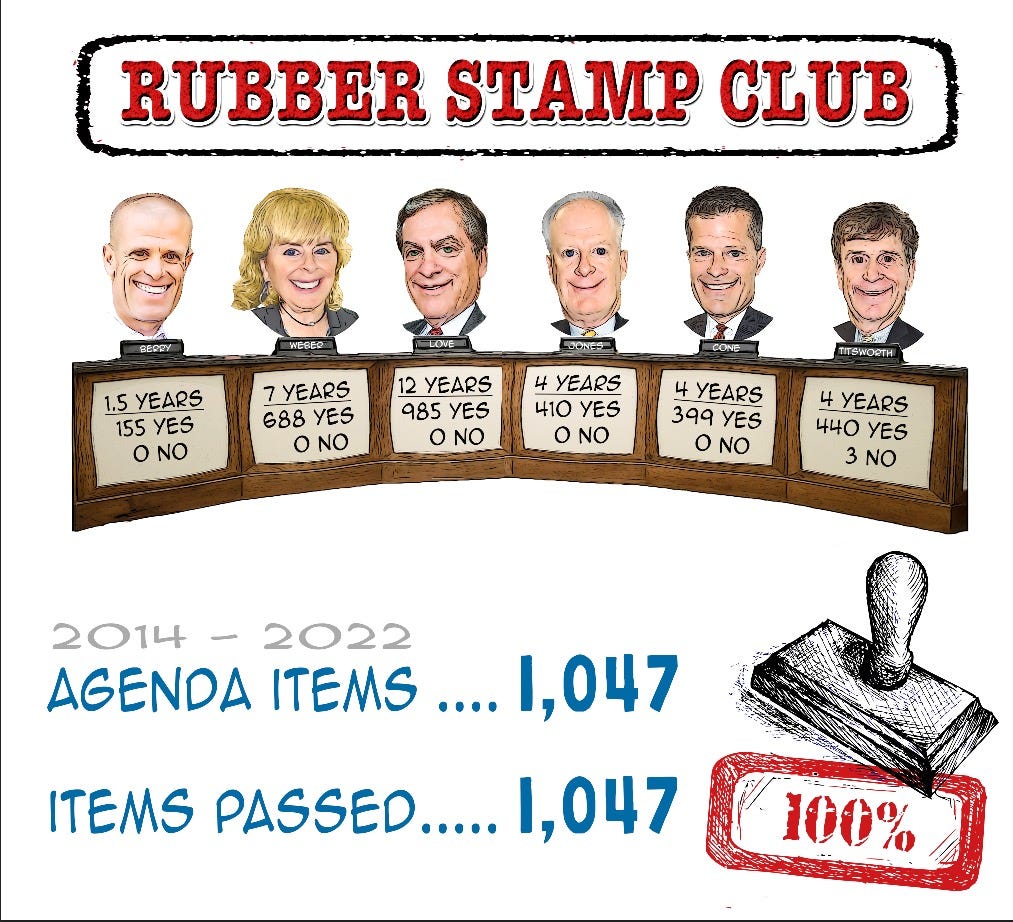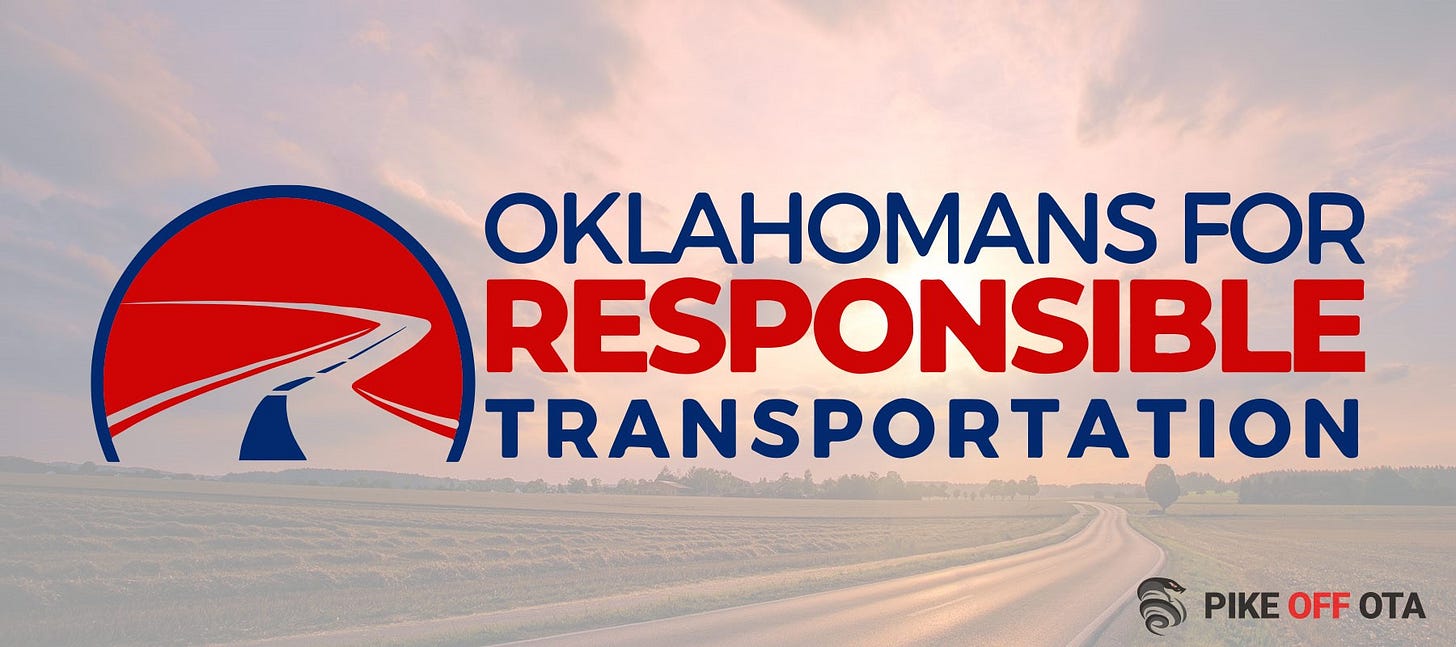Who is the Oklahoma Turnpike Authority - Part 2
Did you really believe the turnpikes would ever be free? Not when a few families can continue to get extremely rich generation after generation.
This story continues where we left off…. in 1955… Check out the Part 1 of the story here.
In 1955, the legislature passed HB933 (curiously the same bill number as 1953 HB933), that would essentially turn the Oklahoma Turnpike Authority into the monster it is today (Figure 3). The 1955 HB933 authorized another turnpike with a route description for an “eastern turnpike.” That route description was amended in 1959 and eventually led to the construction of a turnpike from the Oklahoma Texas line to I40 called the Indian Nation Turnpike, a turnpike that has had little to no revenue generation since it opened in 1970.
The 1955 bill provided that the Trust Agreement(s) for the three turnpikes (the Northern, the Southwestern (H.E. Bailey) and the Eastern (Indian Nation) could contain a provision such that the excess revenues of any one of the three turnpikes could be used to pay the obligations of the other two turnpikes. The bill also provided that when the bonds for any turnpike were “paid-off,” then that turnpike was considered a “paid-out” project and the “paid-out” turnpike would continue to operate as a tolling facility as long as any bonds remained outstanding on any turnpike.
This stunt was called “cross-pledging” and it opened the door for the OTA to build a turnpike anywhere they were legislatively authorized regardless of the justification or potential revenue generation.
A proposed turnpike need not make enough money even to maintain itself because it could be buoyed by “the system.” This legislative amendment was made before any of the other authorized turnpikes (besides the Turner and Will Rogers) were constructed.
Figure 3. May 4, 1955 Daily Oklahoman Article detailing the 1955 HB933 Amendments.
In plain English, that bill gave the OTA two new “powers” that have allowed it to rule over Oklahomans with impunity.
First, it allowed the revenues from existing turnpikes to go to fund the expenses on any new turnpike projects. That means that if you drive the Kilpatrick or Turner Turnpikes, for example, which are two of the profitable toll roads in “the system,” you are literally paying for unprofitable toll roads you are not driving on.
Second, it allows all toll roads to remain under the control of the OTA as long as the bonds to build the new turnpikes aren’t paid off.
Since then, the OTA has engaged in clever bond financing to ensure that their debt servicing continues in near-perpetuity. This method of financing, which is not backed by the full faith and credit of the state, is enticing to those who wish to build and those who wish to earn commissions from bond sales.
To be clear then, the Oklahoma Citizens did NOT vote to allow the turnpike to use cross pledging to keep toll roads around in perpetuity; the political pundits and their well-paid lobbyists in the legislature did. Representative democracy at its finest.
In 1968 the legislature passed HB 501, which was a clean-up bill of sorts (Figure 4). It “codifie[d] all laws pertaining to state highways and eliminate[d] obsolete statutes" and "attempt[ed] to update, modernize, and pull together all the splinter legislation of a generation into one meaningful bundle.” Several amendments were attempted, but most failed. This bill brought all the historical turnpike legislation from Title 69, 1951 Sections 652-672 into the present-day nomenclature of Title 69, Sections 1701-1734.
Figure 4. Newspaper article from 1968 explaining HB501.
With the OTA’s future now codified in perpetuity allowing unrestricted revenue bond sales and limited legislative oversight along with powerful lobbyist groups taking down any opposition, the OTA started requesting more location authorizations ratified in Title 69, Section 1705e. Once authorized, these locations would sit in the statute forever since there was never, and still are no, sunset clauses. In other words, a turnpike location authorized in 1987 but never built, could still, by law, be built in 2024 even though generations have passed and transportation needs have changed. There are currently 600,000 Oklahomans sitting under fifteen general location authorizations that have not been constructed that have no idea their homes and properties could possibly be taken (Figure 5).
Figure 5. General Location Turnpike Authorizations across the state of Oklahoma in Title 69, Section 1705e indicated by shading and numbering. Thin red lines in the center of the map indicate the unauthorized proposed routes by OTA.
The authorizations and bond sales of the constructed and currently proposed routes through time are shown in detail in Table 1 and their locations are shown in Figure 6.
Table 1. Legislative Authorization, Bond Sales and Finished Construction Timeline.
Figure 6. Locations of the Oklahoma Turnpike Authority’s twelve turnpikes relative to Oklahoma Interstate Highway system.
Historical bond sales are shown in Table 2. An interesting note about the historical revenue bond sales is that in Title 69 Section 1701, it states specifically that bonds are supposed to be issued to “construct, maintain, repair and operate turnpike projects,” not issued to pay off ballooning debt that can’t be covered by turnpike revenue. This should call into question their legality, but with no regulatory oversight and rubber-stamping board approval (Figure 7), no enforcement of the statute has occurred over time.
Table 2. Increasing Frequency and Dollar Amounts of Revenue Bond Sales to Mitigate the Ballooning Debt payments amidst growing maintenance costs and lackluster traffic revenues.
Figure 7: The Oklahoma Turnpike Authority Board Voting Record.
Henry Bellmon, a popular Republican governor of Oklahoma from 1963-67 and again from 1987-91 discussed the OTA financing in his autobiography.
“I would have preferred to see the bonds handled as general obligations of the state because under those conditions they could have been auctioned off at the lowest interest rate available and no discount would have been paid. It would have been necessary for the legislature to appropriate money for the engineering, legal fees and costs of sale. This they refused to do. It also would also have been necessary for the citizens of Oklahoma to approve the bond sale in an election.”
Obviously, the OTA didn’t want that. Then he goes on to detail a Supreme Court Bond Validation Case.
“The date for a sale was set for a Monday (1966). The plan was that over the weekend, the sale would be advertised in the necessary legal publications. Late Friday afternoon, a turnpike opponent filed an action in the district court of Creek County challenging the legality of our bond indenture. Dale [Cook], through personal contacts with members of the Oklahoma State Supreme Court, went into action. Late Friday afternoon, he got a sufficient number of members of the Supreme Court in from a golf course in Tulsa where they were holding a State Bar Association meeting. They convened an extraordinary session of the court. The Supreme Court took original jurisdiction of the challenge that had been filed and threw it out of court so that the bond sale could proceed as proposed on Monday. That one action alone probably saved the turnpike refinancing effort.” (Bellmon, 1992, pp. 189).
The OTA has always operated this way.
In the early days of the OTA, they seemed to loosely follow their minimal legislative oversight laws. But since 1987, the OTA began to act brazenly in defiance of what little legislative oversight was actually codified and built several new alignments illegally without legislative location authorization and without legislative bond issue authorization and got away with it.
For example, the 1989 bond issue for the Kilpatrick, Creek, Chickasaw and Cherokee turnpikes stated that all of these turnpikes must be completed under ONE BOND ISSUE and INDENTURE, however, as can be seen in Table 1, the OTA took out multiple bond issues on the Kilpatrick and Creek Turnpikes to complete construction over almost two decades. This language is codified in Title 69, Section 1705f as
“(f) To issue turnpike revenue bonds of the Authority, payable solely from revenues, including the revenues accruing to the trust fund created by Sections 1701 through 1734 of this title, for the purpose of paying all or any part of the cost of any one or more turnpike projects. Provided that any bonds issued for the construction of the proposed turnpike referred to in subparagraphs (10), (20), (21) and (22) of paragraph (e) of this section shall be issued as one issue for all four of the proposed turnpikes and shall be financed, constructed and operated under one bond indenture.”
The second sentence of § 1705(f) strictly limits the OTA’s bonding and building authority in the case of the four turnpikes (part of the Chickasaw, part of the Cherokee, part of the Creek, and part of the Oklahoma City Outer Loop) enumerated in 69 O.S. § 1705(e).
The newspaper accounts of the time reinforced that the intent of the statute was to limit those four turnpikes to be built under one bond issue and indenture (Figure 8). A 1988 Oklahoman article stated that
“[t]he 1987 Legislature approved building of four toll roads, including the Oklahoma City turnpike, but only if part or all of the four roads were built at the same time.”
Figure 8. Newspaper clipping from the Oklahoman. April 22, 1988.
However, the OTA ignored this legislative statute, and in 2017 sold more revenue bonds to build yet another segment of the Outer-Loop (Kickapoo) without legislative authorization (Cerato 2022). Obviously, the OTA decided to fully untether itself from the legislature, and to answer only to itself, and they got away with it.
Due to limited notice requirements in statute, affected residents oftentimes are unaware of what is taking place and have limited opportunities to form an opposition which is why many of the OTA’s unauthorized routes have been built.
The OTA has gone rogue and is no longer limiting their decisions to issue bonds based upon Legislative action but will now take authority to build turnpikes whenever and wherever they wish to build turnpikes, which is what they are trying again with the proposed Tri-City Connector, East-West Connector and the Southern Extension.
The one bond issue and one bond indenture clause in the statute became a central part of the litigation at both the District Court and State Supreme Court with the OTA’s proposed unauthorized routes. Unfortunately, the Citizens lost this litigation in the Supreme Court with a split 6-3 majority opinion on August 1, 2023 after nearly two years of legal battles in both the state District Court and in the State Supreme Court (Case No. O-120619 Oklahoma Turnpike Authority for Approval of Not to Exceed $500,000,000 Oklahoma Turnpike System Second Senior Lien Revenue Bonds, Series 2022). The Judge who authored the Majority Opinion, Judge Winchester, also authored five previous opinions over the past decade in support of the Oklahoma Turnpike Authority. This Supreme Court Case will be discussed in detail in its own set of articles.
Only three of the OTA turnpikes listed in Table 1 are currently revenue positive and are used to fund the entire system maintenance as well as make annual debt payments of roughly $138 million on their $1.7 billion outstanding revenue bond debt, which is more than 38% of their toll revenue. In 2023, their debt payments ballooned to a whopping $164 million which is nearly 40% of their toll revenue. The OTA intends to sell bonds to keep the business going with no intention whatsoever of paying off the debt.
This is a major conflict of interest as the fox guards the hen house!
They are in financial trouble and looking to sell more revenue bonds on new alignments to generate cash to pay off their old debt.
In October 2023, they sold $500 Million in Bonds but only netted $335 Million because they lost $85 Million due to capitalized interest (thought they would sell at 3% interest but ended up closer to 5.2%) and then they had to pay back $80 Million to their general operating fund to cover costs fronted to engineers to design the contested routes in the ACCESS program. Apparently the $335 M will be used first on legacy projects from their Driving Forward program that never got built due to cost overruns (e.g., widening the Turner and widening the Kilpatrick to 6-lanes between I-35 and Broadway Extension).
The OTA is not required to undergo a special or investigative audit by the State Auditor and Inspector before revenue bond sales or before raising toll rates. They are completely financially autonomous with no fiscal oversight even though they hold the sovereign powers of eminent domain from the state. However, due to the excellent work of PIKE OFF OTA, Inc. and friends in bringing to light many problems with the OTA’s financial transactions, the Oklahoma Attorney General called for the first ever external audit on March 15, 2023 (Figure 9); an investigative audit by the Oklahoma State Auditor and Inspector that is currently pending.
Figure 9. Letter from Oklahoma Attorney General Drummond to Oklahoma Auditor and Inspector Byrd requesting an investigative audit of the Oklahoma Turnpike Authority.
*********************To be continued in Part 3
Are you interested in learning more and helping hold a rogue "state instrumentality” accountable to the people? In response to the Oklahoma Turnpike Authority’s legacy of unethical and downright illegal business practices, two Oklahoma non-profits were created to protect Oklahoma Citizens’ private property rights, educate the state on proper transportation planning policy and enlighten lawmakers and other elected officials about the poor business and financial practices that the OTA continues to engage in. PIKE OFF OTA (501 c4) and Oklahomans for Responsible Transportation, Foundation (501 c3) are leading the charge in legal injunctive avenues and legislative reform and they could use your help. They are trying to dismantle a corrupt Goliath within our state and are doing a great job. Be part of the solution!

